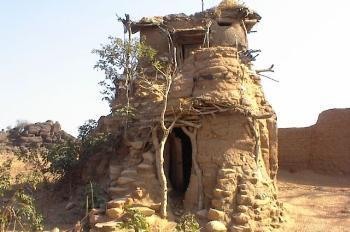
HIDDEN TREASURES OF THE GOLD COAST
“Travel makes one modest, you see what a tiny place you occupy in the world”. – Gustave Flaubert
For those of us who are intrigued by mystery and religious believes, this week’s tourist site will not only leave you beginning for more but well on your way to visit the site that combines the elements of Ghana’s revered hospitality and African mysticism into one beautiful attraction that would leave visitors awed.
Come along with Hidden Treasures as we take you to the Upper East region of Ghana for a once in a lifetime opportunity to see, experience and partake (if you choose to) of a “nude” ritual to bring you blessings, protection and prosperity. Welcome to Tongo, land of the mysterious whistling rocks and shrines.
TONGO WHISPERING ROCKS AND TENGZUG SHRINE
Tongo is a small town near the Upper East regional capital, Bolgatanga, and the capital of Talensi-Nabdam district, a district in the Upper East Region of Northern Ghana. Tongo is known for the, Tengzug shrine, Tongo whispering rocks and for its sowing and harvest festivals.
The Tengzug shrine, tucked away in the remote village of Tengzug in Tongo, is unique due to its origin and the way in which local people worship in it.
The Tongo Hills and Tengzug Shrine are located in the village of Tengzug, 17 kilometers (about 10 miles) southeast of Bolgatanga. With its landscape dominated by large granite formations, the Tengzug area evolved as the sacred centre of the Talensis people, an ethnic group in Northern Ghana. The Tengzug Shrine is located in the Tongo hills and is believed to grant luck and prosperity to all those who visit it.
Tengzug Shrine and Whispering Rocks
As you make your way into the village, which is set apart from other more remote villages nearby, you discover thatched roof huts that are creatively adorned and painted by the women of the village. During their downtime, prior to harvest, the women utilize the sun’s baking heat to make very beautifully painted works of art. The huts are an extension of the tribe’s massive cultural hub and craft markets.

Also in Tongo, another visitor’s sight in the town is the Tongo Whistling Rocks. These granite rocks jut dramatically from the terrain. The rocks also make a strange whistling sound during November and December, when the harmattan wind blows from the Sahara throughout the Northern Region. Baobab trees make the Saharan landscape a breathtaking sight to behold.
The Talensis of Northern Ghana require you to be topless to observe one of their sacred rituals. With the smell of animal blood and feces bombarding their senses, man and woman alike must bare themselves to the sub-Saharan heat to enter the Tengzug Shrine in the Tongo Hills.
The Tengzug Shrine, one of the most famous in the region, was once a hideout for slaves evading their captors. Now, it is used more traditionally for religious animal sacrifices for good luck and to please the ancestors of the Talensis. With a guide, visitors can scale the rocks up to the Tengzug Shrine, remove their tops and witness the sacrifice of birds and chickens.
In the shrine, among the remnants of the recently sacrificed, visitors get a panoramic view of the region and the surreal world of the Tongo Hills. Giant Baobab trees and boulders define the dry landscape that draws both tourists and religious pilgrims. The Tongo Hills comprise only twenty square kilometers, but are richly packed with history, religious significance, and fantastic hiking.
Along with the many shrines tucked away in the rock formations of the area, the local population has rebuilt a number of classic Talensis homes.
Shaped like cylinders and grouped into neighborhoods, the homes have miniature doorways, followed by a short wall inside the home that allows for protection from intruders. Other than the doorway and a few holes for smoke to exit the structure, they are completely closed off to the outside world.
The Tongo Hills give visitors a window into the world of the Talensis, and visitors coming at the right times can experience one of the region’s vibrant festivals. In March, the Talensis celebrate the Golob Festival focusing on the sowing of the fields. With a bit more show to it. The Bo’araam Festival in October and November includes drinking traditional beer and the sacrifice of donkeys, goats, and fowl.
Despite their strange and unconventional religious rites and the fact that they worship nude in shrines, the people of Northern Ghana are very intriguing and special. They are known the world over for their fantastic art and culture. The architecture in their villages is impossible to beat. This remote area of the world has been left unaffected by technology and modern inconveniences.
Visitor Account
Bolgatanga is hot. It is doubtless among many other things, but it’s hard to appreciate them in such intense heat. The stifling, windless air feels like it is slowly cooking you; plastic chairs burn your legs; the heat rising from the dirt roads passes through your sandals and warms your feet. To confirm, it’s hot in Northern Ghana.
Shrines at Tengzug
Luckily the Sand Gardens hotel, on the town’s outskirts, has several large mango trees in its spacious grounds. After arriving from Tamale in a Flintstones-era bus – complete with holes in the floor for your feet – Hannah and I headed instantly for their shade.
Faced with these options – blistering sunshine versus cool shade – it was tempting to spend both of our days in ‘Bolga’ hidden at the hotel. But describing the drinking of various soft drinks in a hotel would make for a fairly dull blog. So early next morning, we slapped on the factor 50, bought loads of water and hired a taxi to take us to the nearby Tongo hills.
The chief’s palace
The village of Tengzug is the site of several shrines. Ernest, our guide, met us as we arrived and took us to greet the village chief. After a smile and a wave from the big man, we climbed to the roof of his house to admire his compound. It’s reputedly the largest chief’s dwelling in Ghana – and he needs it, having 18 wives and 350-odd relatives to share it with. Valentine’s Day must take a fair bit of planning in Tengzug.
Various dead animals
We went to explore the small, mud-built houses, one for each family group. The dwellings are all built into each other and connected by a labyrinth of narrow passages. And outside each house is a shrine – a stone stump plastered with chicken blood and feathers, or occasionally decapitated livestock stuffed with leaves and various charms. They looked vaguely sinister but were also intriguing – it’s not every day you see a headless goat with leaves up its bum.
Ernest then took us to the cave shrines among the ‘whistling hills’ – so-called because of the sound the wind makes as it passes through the rock formations during the Harmattan. As we walked, our conversation turned to the forthcoming Champions League games, and at the first shrine, Ernest’s efforts to inform us about his community’s traditions were betrayed by his love of football.
‘This is the donkey shrine, where people leave the skulls of their dead donkeys.’
‘Why do they leave the skulls here?’
‘To represent hard work by their animals. ‘Who comes to visit the shrines?’
‘People come from very far, from many lands.
Ernest refocused sufficiently to remember tradition, so we left Hannah by a rock – no girls allowed at the shrine – and removed our shirts and sandals before climbing over the scorching rocks to the cave that holds the shrine. Inside sat the priest, wearing scruffy grey shorts and nothing else. Filling much of the cave was the biggest pile of dead chickens I have ever seen. I was asked if I would like to make a sacrifice, for wealth or to help my family prosper; I wasn’t sure of the vegetarian position on chicken sacrifice, so I declined.
The priest then said something to Ernest, who translated for me: ‘He would like to know if you are a Barcelona fan’. Lying topless with two other men in a cave full of dead chickens, discussing Barcelona with a tribal priest, must count as one of the most surreal moments of my life (and I lived in Brighton for five years). I told the priest I supported Liverpool, wished Barca luck for their game against PSG, and then made my way down to the relative normality of the Tengzug chief with his 18 wives and collection of leafy-bum goats.
How to get there
Visitors can pick public bus from Accra through Kumasi to Tamale. This is often cheaper and safer. It takes 3 hours from Tamale, leaving around 8AM so make sure you make a bathroom stop on the lunch stop as you might not be able to otherwise.
Taking a taxi is the easiest way for tourists to get around in Bolgatanga. Taxis can be found close to the market and bus loop along the Bolga-Tamale road.






























